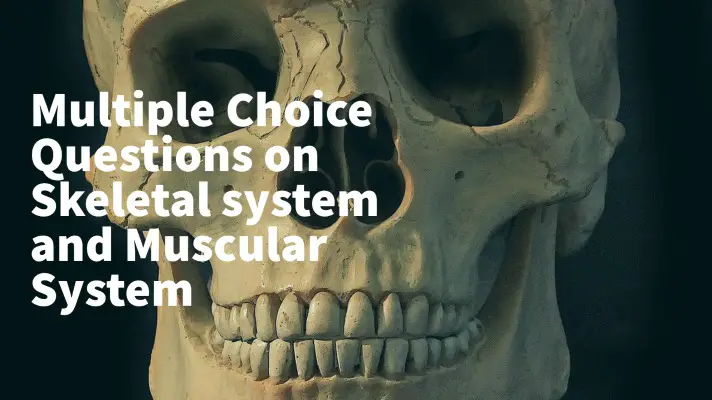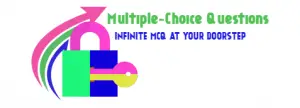If you are searching for MCQ Questions on Skeletal system and Muscular System, then you are in the right place. Here, you will learn how does the human body work wonderfully with the combination of the skeletal and muscular system through some multiple-choice questions.
Further, there is also a quiz on Skeletal system and Muscular System. At the end of this article, you can download the MCQ sheet by clicking on pdf downloadable button.
So, now let us jump into the MCQ section:

MCQ on Skeletal System and Muscular system
- Skull is made of _____ numbers bones.
- 18
- 20
- 22 ✔️
- 24
- An adult human has _______ numbers bones.
- 202
- 204
- 206 ✔️
- 208
- An adult human has _____ numbers teeth.
- 30
- 32 ✔️
- 34
- 36
- How many bones are there in head?
- 6
- 7
- 8 ✔️
- 9
- How many bones are there in face?
- 11
- 12
- 13
- 14 ✔️
- All the blood cells are manufactured within the ____.
- bone marrow ✔️
- blood vessel
- nerves
- none of these
- Which blood cells carry oxygen to the different parts of the body?
- white blood cells
- red blood cells ✔️
- Both of the above
- None of the above
- Which blood cells protect the body against infection?
- white blood cells ✔️
- red blood cells
- Both of the above
- None of the above
- Which jaw in our face is fixed?
- lower jaw
- upper jaw ✔️
- both
- none of these
- How many long curved bones are there to form the rib cage?
- 14 pairs
- 14 numbers
- 12 pairs ✔️
- 12 numbers
- Floating ribs are the ______ pairs of ribs.
- 2 ✔️
- 3
- 4
- 5
- Floating ribs are joined with the ____.
- breast bones
- back bone ✔️
- both of the above
- none of the above
- The ribcage protects the _______.
- hearts
- lungs
- both of the above ✔️
- none of the above
- Backbone consists of ___numbers of small and hollow bones.
- 11
- 22
- 33 ✔️
- 44
- Backbone consists of some small bones. These are called as ____.
- ribs
- vertebrae ✔️
- limbs
- None of these
- Which bone is known as femur?
- thigh ✔️
- arm
- backbone
- none of these
- The longest bone is called as _______.
- Carpals (in the hand) and
- tarsals (in the feet)
- femur ✔️
- none of these
- Tarsals is the bone of ___.
- hand
- leg
- feet ✔️
- thigh
- Carpals is the bone of ____.
- hand ✔️
- leg
- feet
- thigh
- ______are the storehouse of minerals like calcium and phosphorus.
- joints
- bones in skeleton ✔️
- blood cells
- none of these
- Muscles are connected to the bones by ____.
- blood
- fibres ✔️
- none of these
- The strong fibres in the muscles are known as _____.
- tendons ✔️
- marrow
- limbs
- none of these
- There are ______ different kinds of muscles in our body.
- 450
- 550
- 650 ✔️
- 750
- How many different types of muscles are there in our body?
- 5
- 4
- 3 ✔️
- 2
- Voluntary muscles are located at ______.
- tongue ✔️
- heart
- stomach
- intestitine
- Involuntary muscles are located at ______.
- eyes
- hands
- intestitine ✔️
- heart
Quiz on Skeletal System and Muscular system
Here is the quiz for you. Best wishes!
Overview
The multiple-choice questions mentioned here are the basic questions from the chapter- skeletal and muscular system that will help you in getting good scores in exams.
You can get the answers of all the questions along with the explanations here. Therefore, it is very essential to have a look at the following text.
The skeletal and muscular system
Skeleton is the framework of our body. It provides the structure to the body. It is covered with flesh and skin.
The skeleton gives:
- shape and support to the body.
- protect our delicate organs.
- is five times stronger than steel.
- facilitates movement.
This system includes over 200 bones, cartilage, and ligaments. Bones are hard structures made of living cells and minerals. More than half of the total number of bones are found in our hands and feet.
An adult human has 206 bones and 32 teeth. When you look closer, you will see more structures.
The long bones are in legs and arms. The rib bones are round in shape. The bones have tiny hole in it. Nerves and blood vessels enter the bones through these holes.
Within the long bones, there is a soft, fatty substance which is called bone marrow.
All the blood cells are manufactured within the bone marrow. Red blood cell and white blood cell are within the blood. The red blood cells carry oxygen to the different parts of the body and the white blood cells protect the body against infection.
Different parts of the Skeleton
Skull
- Hard bony structure which protects the brain is called as skull.
- Skull is made of 22 bones.
- There are 8 bones in the head. These bones are interlocked together to cover our head.
- The balance 14 bones are in the face.
- The lower jaw is not fixed. This movable lower jaw helps in talking and eating.
- Balance all these bones are fixed.
- The upper and lower jaw contains teeth that help us in cutting and chewing the food.
Rib Cage
Here are the details for rib cage:
- A set of 12 pairs of long curved bones surrounding the chest in the form of cage is nothing but Rib cage.
- Ribs are joined to the backbone at the back and to the breast bone at the front.
- Floating ribs are the two pairs of ribs. These two pairs are joined only to the backbone and not to the breast bone.
- The ribcage protects the heart and the lungs.
Backbone or spine
- The backbone supports the body and protects the spinal cord.
- The backbone is also known as vertebral column.
- It consists of 33 numbers small and hollow bones which are called vertebrae.
- These bones are arranged in such a way that it forms a tube like structure.
- It protects the spinal cord and helps us in bending and taking turns.
Limbs
- The two pairs of limbs have the forelimbs( or arms) and the hind limbs( or legs).
- The arms are connected to the backbone with the help of shoulder girdle.
- The thigh bone is also known as femur which is the longest bone in our body, bears the weight of the body.
- The frontal bone is a flat bone.
- The patella, also called the knee cap, is a sesamoid bone.
- Carpals (in the hand) and tarsals (in the feet) are examples of short bones.
Function of Skeleton
- The skeleton which gives shape, strength and support to the body, helps us to stand.
- It covers and protects our internal organs and the brain.
- The backbone protects the spinal cord and the rib cage protects the lungs and heart.
- It helps in movement of the different body parts.
- It contains bone marrow where white blood cells and red blood cells are produced.
- Bones are the storehouse of minerals like calcium and phosphorus.
Joints
The locations where two or more bones meet or join together are called joints. Bones are held together with the help of the joints of strong tissues called ligaments.
Most of the joints can move but the joint in the tooth socket and in the skull can’t move.
Types of joints
The movables joints are of four types. They are:
- Hinge joint
- Ball and socket joint
- Pivot joint
- Gliding joint
Hinge joint
The joints in elbow, knee, finger and toes can move in one direction only. This type of joint is called hinge joint.
Ball and socket joint
Circular movement of the joints are found in shoulders and hips. Here, one bone that ends in a ball fits into the socket or hollow of another bone. This is called ball and socket joint.
Pivot joint
In this joint, the rounded surface of one bone fits into a ring formed by the other bone. It allows rotation only. This is called pivot joint.
Joint between the neck and the head is a pivot joint.
Gliding joint
It allows movement between the connecting bones like wrist, ankle or the vertebrae of the spine.
Muscles
Muscles are fleshy bundles of thin, elastic like material in the body which are connected to the bones by strong fibres called tendons. There are 650 different kinds of muscles in our body and each is responsible for a particular movement.
Eye muscle is the most active muscle in our body.
Types of Muscles
There are three types of muscles in our body:
- voluntary
- involuntary
- cardiac.
Voluntary or Skeletal Muscles
Most of the muscles in our body are under our control. In arms, legs, eyes, tongue, etc., these muscles are found.
Involuntary Muscles or Smooth Muscles
The muscles which are not in our control are called involuntary muscles. They work automatically. They are found in our stomach, intestitine, etc.
Cardiac or heart muscles
These muscles are found in the heart. They are involuntary and work throughout our life without stopping or getting tired.
How do Muscles work?
Muscles work in pairs by contraction and expansion. A contracted muscle becomes tighter and shorter. When an expanded muscle is relaxed it goes back to its original shape. The biceps and triceps in our body arms are voluntary muscles that work together.
Functions of muscles
Important roles of muscles are:
- Movement of the human body are a result of muscle contraction. They pull the bones to cause movements.
- Muscles hold our joints firmly and prevent them from being damaged while moving.
- Skeletal muscles help in maintaining our body posture.
- Muscles produce heat when they use energy.
You must appear for the test of 25 marks on the skeletal and muscular system . After completion of the test, you can check the answers and can come to know how much you are prepared. I hope that the article is helpful to you. Thank you for reading. Best wishes!



Hey
You’re notes are superb
It’s really helpful
Thank you soo much
Thanks a lot.
I love this
It’s simplified and understanding
It’s really helpful
And I believe that because of this understanding, I’ll pass my quizzes
Thank you so much ??
Thank you so much. Best Wishes!